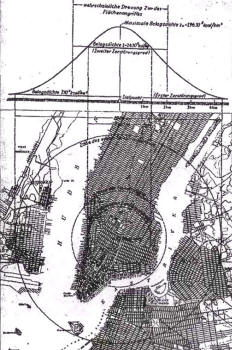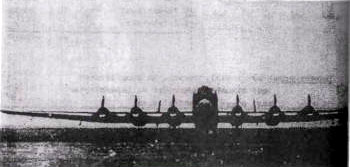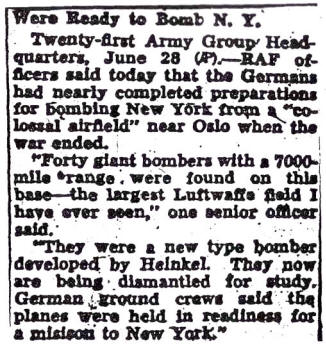|
Chapter 5 STRANGE MAPS, STRANGE FLIGHTS, AND UNKNOWN CARGOES
1 Jeremy Bernstein, Hitler's Uranium Club: The Secret Records at Farm Hall (Copernicus, 2001), p. 126. The United States was in a unique position among all the powers involved in World War Two. For the last time in its history, it was able to undertake military operations on a global scale relatively free of the fear of enemy reprisal. Its cities and factories were beyond the reach of any known enemy bomber. Moreover, much of its industrial capacity was located in its interior, far from the northeastern Atlantic States or the Pacific coast. According to conventional wisdom that has been reiterated countless times in numerous standard histories of the war, there was absolutely nothing the United States had to fear from Nazi Germany with its "tactical mission-oriented Luftwaffe" or its puny navy. To this day, many Americans, even ones relatively familiar with the operational details of Word War Two, believe that Germany had no aircraft even capable of reaching the United States and returning to Europe, much less of carrying a heavy enough payload, or being available in sufficient numbers, to be of any military significance. All that changes, however, if Germany had the atomic bomb and if she possessed aircraft capable of delivering one and of returning successfully to Europe. In that case, only one bomber need be used to strike a significant military and psychological blow against the United States.
A. The Oberkommando der Luftwaffe's Unusual Map In 1943 the Supreme Command of the Luftwaffe (Oberkommando der Luftwaffe) conducted a highly unusual study. The study consisted of a map, a map of lower Manhattan Island. On the map are concentric circles detailing the blast and heat damage- radii of an atomic bomb detonation over New York City. But the most unusual aspect of this "study" is that it shows the detonation of an atom bomb in the 15-17 kiloton range, approximately the same yield as the Little Boy uranium bomb dropped on Hiroshima, an odd "coincidence" in the series of "odd coincidences" we have- already encountered. The Luftwaffe's intentions are quite obvious and clear. The destruction of the financial and business center of New York City would alone have been an unparalleled military and psychological blow against the American war effort. Beyond this, given the fact that New York City was an important point of embarkation for American shipping and troops, as well as a naval base, and a transportation hub for the entire American northeast, such a blow would have been incalculable. For the Nazi leadership, such a blow would have made military and political sense. It would have demonstrated conclusively to the United States that Germany was capable of mounting significant military operations against the American mainland, and at levels of destructive capability that were militarily, economically, and psychologically devastating. From their point of view, such a blow would arguably been seen as weakening American resolve and perhaps, after a succession of similar such blows against prominent targets such as Boston, Philadelphia, Washington DC or Norfolk, would conceivably have led to America's exit from the war, leaving Britain to follow not far behind. The war against the Soviet Union could then either have been prosecuted without mercy until the inevitable Soviet capitulation, or at the minimum, a negotiated peace highly favorable to the Reich. In October of 1943, then, such a study was a tempting prospect. But is there any indication that the OKL's "study map" was anything more than a study? From the evidence presented thus far, the answer is clearly that the Luftwaffe was not merely conducting the typical staff exercises that all general staffs conduct, even in wartime. For the Luftwaffe, the study was a practical and immanent feasibility. The OKL 's "Feasibility Study" of an Atom Bomb Blast of Hiroshima Size over Manhattan Island in New York City But what of Freier's allegations that the bomb was ready, but the delivery systems were not? Without a delivery system the German Wehrmacht could have possessed all the atom bombs it wished, but they would have been utterly useless, expensive toys, without a viable means to deliver them to its most significant militarily and economically powerful opponent.
Did the Germans possess any strategic bombers or aircraft capable of reaching the North American continent with a significant payload, and returning to Europe? Beyond the relatively well- known Messerschmitt 264, a four engine bomber that looks far too similar to the American B-29 to be coincidental, Germany possessed in small numbers a quantity of heavy-lift, ultra-long range transport craft, including the four engine Junkers 290 and its massive six engine cousin, the Junkers 390. The Junkers 390 Only two of these massive aircraft were ever built. The Junkers 390 assumes an odd significance here (and later) in our story, for in 1994, one such Ju 390 took off from Bordeaux, France, and flew to within 12 miles of New York City, snapped a picture of the Manhattan skyline, and flew back, a non-stop flight of 32 hours. Within the context of the German SS atom bomb project, this flight was more than a mere feasibility study. Photo reconnaissance could only be for target identification. And the flight itself, to within 12 miles of the city, could conceivably have been a test of American air defenses and reactions. In any case, the fact that such a flight returned safely can only indicate that the American Army Air Force simply was not expecting a visit from the Luftwaffe at all, reconnaissance, feasibility study, or otherwise. The Messerschmitt 264 Long Range "Amerikabomber ", Note the Curious Resemblance to the Boeing B-29 Superfortress
C. Unknown Cargoes and a Curious Airfield The Ju 390 and is smaller four engine cousin the Ju 290 will play another important role in subsequent parts of this book. Hut perhaps they had a role envisioned for them in conjunction with another little-known, but nonetheless important, fact. In 1945 the Luftwaffe completed construction of an enormous airfield near Oslo, Norway, capable of handling v e r y large aircraft like the Me 264, the He 177, and the Ju 290 and 390. In an article for the June 29, 1945 issue of the Washington Post, a report that originated from 21st Army Group headquarters outlines the frightening discovery that awaited Allied military personnel who came to occupy Norway after the German forces there surrendered:
It is known that Heinkel undertook special modifications of its He 177 four engine heavy bomber late in the war, adapting it to carry large atom bombs, radiological bombs, and biological and chemical bombs.2 Within the context of the SS atom bomb program and the earlier flight of the Ju 390 from France in 1944, however, a purpose immediately suggests itself. The loss of France to Allied forces in 1944 deprived the Luftwaffe of its large French airfields. Norway, however, as has already been stated, remained in German hands up until their very surrender, and thus constituted the only remaining base of operations available to the Germans for any type of offensive operation against the North American continent. 2 Q.v. Friedrich Georg, Hitlers Siegeswaffen band 1: Luftwaffe und Marine: Geheime Nuklearwaffen des Dritten Reiches und ihre Tragersysteme pp. 131, 133. The presence of such an airfield and its deliberate construction so late in the war also strongly suggests a connection to the SS atom bomb program in an entirely different way, since its construction would likely have fallen under the jurisdiction of the SS Building and Works Department, which was under the direction of none other than SS Obergruppenfuhrer Hans Kammler. It is also significant that jurisdiction over all long range aircraft was also in Kammler's hands by war's end, thus linking the precious long-range bombers on the Oslo field to Kammler as well. Moreover, Mayer and Mehner speculate that at least two atom bombs were built and possibly transported on the mission of the U-234. In their view, the surrender of the U-boat to the American authorities thus not only provided the Manhattan Project with much-needed stocks of enriched uranium, but quite possibly also with two fully functional atom bombs as well. Professor Friedrich Lachner was assistant for twenty years to professor Mache at the Department for Technical Physics at the Technical University of Vienna. Familiar with aspects of the German bomb project, Lachner unburdened himself of his knowledge to researchers Mayer and Mehner. Among his allegations were that at least one completed bomb of German construction was transported from Thuringia to Salzburg by the SS near the end of the war.3 Lachner's letter is intriguing for two reasons. First, because it corroborates the existence of a large atom bomb program in the Three Corners region, and corroborates Freier's allegations of a successful test in March 1945. By mentioning the transportation of such weapons out of the region, he gives some credence to the idea that the U-234 might have been used to transport at least one such weapon to Norway.4 3 Mayer and Mehner, das Geheimnis, p. 81. Lachner also asserts unequivocally in his letter to Mayer and Mehner that the bomb dropped on Hiroshima was German (p. 82). Lachner also states that there were no less than fifteen atom bombs in German hands by the war's end. Again, on first glance, this seems a sheer fantasy, unless they had already mastered the techniques of boosted fission. The Salzburg bomb story may not be fantasy, as American tank units were operating in the area late in the war (q.v. pp. 84-85) in conjunction with Patton's drive on Pilsen and Prague. 4 Italian officer Luigi Romersa mentions as well that the Russians captured two such bombs (Das Geheimnis, p. 105). But a more curious allegation is made in Lachner's letter to Mayer and Mehner, and with it, we begin to approach the even more horrendous potentialities of Nazi wartime secret weapons research. Citing the letter of a British espionage agent who was well-aware of the multi-tiered nature of the German atom bomb program, and who was aware of a "third team that sought another way" of making the bomb (boosted fission), 5 he then mentions a "fourth team":
Mayer and Mehner then point out the implications of the agent's remarks in an age long accustomed to think in terms of the destructive power of hydrogen bombs:
5 Mayer and Mehner, Das Geheimnis, p. 89. It should be noted, however, that the name of this "well known" British agent is never mentioned. 6 Ibid., p. 91, my translation and emphasis. The agent then mentions that he is not aware of which side ended up with this technology. 7 Ibid., pp. 91-92. it is also a legitimate question to ask whose military possesses it, or alternatively, is it in the possession of some altogether unknown entity? The truthfulness of these stupendous allegations appears to be substantiated by a brief remark uttered by Adolf Hitler to a gathering of Axis elite in April 1944. According to Italian officer Luigi Romersa once again, who was present when Hitler made the remarks, the Fuhrer strolled through the room and said,
Bacteriological war? Bombs with an unbelievable working? Teams of specialists working in areas that defy conventional laws of physics that would threaten a global catastrophe? This is not the picture of a Germany tinkering with V-l buzz bombs, V-2s of limited operational range and strategic value, clumsy and belated attempts to construct a working atomic reactor, and tottering on the brink of total collapse that we have been led to believe. All the evidence presented thus far tends to the opposite conclusion, that at a minimum the Third Reich possessed functioning atom bombs and was preparing to use them against the West, if she had not already done so against Russia. So the cargoes intended to fly out of that Norwegian airfield may have not only been nuclear, but something far more horrendous. Already the path through Nazi Germany's nuclear programs have led into very unexpected places and developments, developments only made possible by the recent German reunification and the declassification of German, British, and American archives that it provoked, and suggesting that behind that nuclear program lurks something even larger and far more monstrous. In any case, it now seems clear why, in spite of Oppenheimer's statement in the middle of May 1945 that the earliest an atom bomb could be ready was in November of 1945,9 that America was able to overcome all fusing problems and fissile material shortages in a mere two months after the German surrender. 8 Mayer and Mehner, Das Geheimnis, p.
97. The June 29, 1945 Washington post Article on the Luftwaffe Airfield in Oslo and its Forty Long Range Bombers Back to Contents |



